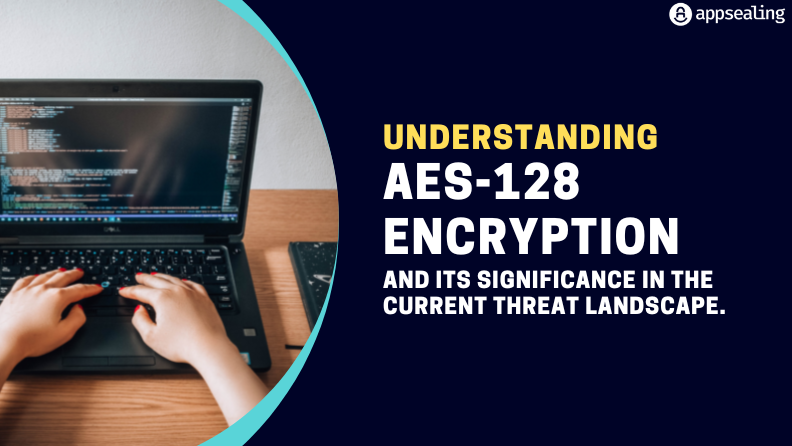
As data travels through different networks, there is an increased possibility of attacks. AES is the encryption standard used by organizations worldwide to secure sensitive data. AES was published when the need for a better encryption model became apparent. While Data Encryption Standard (DES) was used for around 20 years, AES came as an alternative to DES when it started becoming vulnerable to brute force attacks.
AES comes in 128, 192, and 256 bits. This article will help you understand the AES-128 in detail.
AES-128 Encryption
AES-128 conceals plaintext data using an AES key length of 128 bits. AES-128 encrypts data using 10 transformation rouns and is best suited for protecting secret government information as recommended by the National Security Agency (NSA). The block size of the data encrypted using AES is always 128 bits. 128-bits is the least secure among other variants of the AES algorithm. However, this doesn’t mean that AES-128 is crackable. Since other variants such as 192-bits and 256-bits use more rounds for transformation, AES-128 is comparatively less secure.
The steps involved in AES-128 encryption include the substitution of data using a substitution table, shifting rows, mixing columns, and insertion of another round key.
How Secure is AES-128 Against Brute Force Attacks?
AES processes 128 bits of input data at a time. Based on the substitution-permutation network, AES is a symmetric key. AES performs all its computations on bytes which means it treats the 128 bits of a block as 16 bytes. The bytes are processed as a matrix with 16 bytes organized into four columns and four rows. DES with a key size of 56 bits has been cracked using brute force attacks in the past. AES-128 is a 128-bit symmetric key that is computationally secure against brute force attacks.
If you ask how long will it take to crack 128-bit encryption using a brute force attack, the answer would be 1 billion years. A machine that can crack a DES key in a second would take 149 trillion years to crack a 128-bit AES key. Hence, it is safe to say that AES-128 encryption is safe against brute-force attacks. AES has never been cracked yet and it would take large amounts of computational power to crack this key. Governmental organizations and businesses trust the AES for securing sensitive information.
What’s the difference between AES-128 and AES-256?
AES is considered safe against brute force attacks. Key size is a critical factor in determining whether the algorithm can be cracked. The key size should be large enough to resist attacks from modern computers with large computational power. Understandably, a 256-bit is more difficult to crack due to its key length. However, even cracking a 128-bit key would need quantum computing to generate the necessary brute force.
One of the major differences between AES-128 and AES-256 is that the latter takes longer to execute and requires more computational power. Hence, wherever power and latency are a concern, AES-128 encryption is recommended.
Regardless of whether AES-128 or AES-256 is used, the surrounding infrastructure should be strong and secure to keep hackers from breaking into the system. The software implemented should be secure and perform functions as the user wants it to. Every organization should have strict guidelines for data handling and storage. Users must follow the security best practices irrespective of what encryption model is being implemented.
Choosing between AES-128 and AES-256
As stated earlier, AES-128 uses a 128-bit key length to encrypt and decrypt a block of message whereas AES-256 uses a 256-bit key length to encrypt and decrypt a block of message. Both encryption models have their own pros and cons.
AES-128 has greater speed. It is comparatively more efficient and resistant to full attacks. AES-128 is suited to protect secret information. AES-256 on the other hand may be a bit slower and take longer to execute. However, it is used to protect the top-secret information of the government. AES-256 can resist brute force attacks but may not safeguard against related-key attacks.
AES is the modern encryption standard capable of resisting attacks in the current threat landscape. Choosing AES-128 or AES-256 depends on each organization’s individual security needs. AES-18 is fast and resource-efficient and provides enough security against cyber attacks. But organizations that deal with highly sensitive information such as the defense sector should go with AES-256 as the longer key size provides extra protection against attacks.
Final Thoughts
A 128-bit level of encryption has 2128 possible key combinations. AES is by far the most advanced encryption trusted by organizations worldwide. AES-128 is strong enough to meet future security needs. AES is used in self-encrypting disk drives, database encryption, and storage encryption. AES can be safely implemented in firmware, hardware, and applications that need low latency and high throughput.
In the present day, AES is widely used in software and hardware. AES assures security only if the implementation is right. Keys should be stored properly as hackers can easily misuse data if they get their hands on the keys. Key management is critical to ensure AES provides a strong defense against attacks. AES remains the best choice for securing communications as it has more key length options.
Appsealing is a robust mobile app security solution provider that ensures in-app protection with zero coding. It makes mobile security holistic and effective with real-time updates. Add scalable protection to your mobile apps with security solutions that are compatible with third-party libraries and provide threat analytics on attack vendors. Get in touch with AppSealing for end-to-end protection for a range of applications.